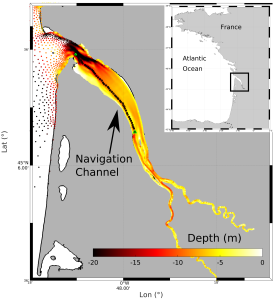Gironde Estuary, France – Estuario de la Gironda, Francia
The presence of seawater and freshwater in estuaries generates a flow that persistently pulls ocean water into the estuary and sends a mixture of ocean and river water to the ocean at the surface. This is known as exchange flow and it is a major driver of residence times and water quality in estuaries and coastal areas.
The Gironde Estuary is a tidally driven and highly turbid estuary located on the southwest coast of France. This system varies from well-mixed in summer to partially stratified during winter-spring. PhD student Cristian Rojas is working with Dr. Lauren Ross to study the spatial variability of the exchange flow and fresh-saltwater mixing in the Gironde using numerical simulations. The goal is to compare the drivers of exchange flow between the Gironde and other systems in the world (Reloncavi Fjord, Chile and the Penobscot River Estuary, Maine, USA) to help determine the drivers of transport in each system and how to best design field experiments to collect data on exchange flows. Cristian and Lauren are collaborating with Dr. Aldo Sottolichio from the University of Bordeaux, France on this project.
Versión en español: La presencia de agua de mar y agua dulce en los estuarios genera un flujo que persistentemente atrae agua oceánica al estuario y envía una mezcla de agua de mar y de río al océano por la superficie. Esto se conoce como flujo de intercambio y es un factor determinante en los tiempos de residencia y la calidad del agua en los estuarios y áreas costeras.
El estuario de la Gironda es un estuario impulsado por las mareas y con alta turbidez ubicado en la costa suroeste de Francia. Este sistema varía desde estar bien mezclado en verano hasta parcialmente estratificado durante el invierno-primavera. El estudiante de doctorado Cristian Rojas está trabajando con la Dra. Lauren Ross para estudiar la variabilidad espacial del flujo de intercambio y la mezcla de agua dulce y salada en la Gironda utilizando simulaciones numéricas. El objetivo es comparar los factores que impulsan el flujo de intercambio entre la Gironda y otros sistemas en el mundo (Fiordo Reloncaví, Chile y el estuario del río Penobscot, Maine, EE. UU.) para ayudar a determinar los factores de transporte en cada sistema y cómo diseñar de la mejor manera los experimentos de campo para recolectar datos sobre los flujos de intercambio. Cristian y Lauren están colaborando con el Dr. Aldo Sottolichio de la Universidad de Burdeos, Francia, en este proyecto.

